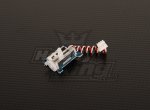Hi all, new to the forums and a complete noob when it comes to playing around with circuit boards and such.
As part of an experiment I need to move two small components of my apparatus back and forth at irregular intervals and have decide to use the PICAXE-08 servo driver to control two HXT900 servos.
I want to be able to precisely control the time that these components move and so I will be powering the servo driver from a computer controlled amplifier which also controls other aspects of my experiment.
Question1: I was wondering if the 5V pulse TTL that this amplifier supplies is enough to drive the servo driver, as it says that it requires 6V.
Question2 is about how to program the PICAXE-08M2 chip. Whenever I turn on the servo driver by supplying it with a 5V TTL pulse I want it to check the position of each servo motor, and move it to a preset position depending on where each one currently is. Is something like the following possible to program with the chip:
Manually turn power on
If servo 1 is at 0 degrees, then move servo 1 to 120 degrees
Elseif servo 1 is at 120 degrees mover servo 1 to 0 degrees
If servo 2 is at 0 degrees, then move servo 1 to 120 degrees
Elseif servo 1 is at 120 degrees mover servo 1 to 0 degrees
Is it possible to write a program that does the above using the servo driver?
Many thanks for any help and sorry if this is unclear, I will try to explain it better if required.
Josh
As part of an experiment I need to move two small components of my apparatus back and forth at irregular intervals and have decide to use the PICAXE-08 servo driver to control two HXT900 servos.
I want to be able to precisely control the time that these components move and so I will be powering the servo driver from a computer controlled amplifier which also controls other aspects of my experiment.
Question1: I was wondering if the 5V pulse TTL that this amplifier supplies is enough to drive the servo driver, as it says that it requires 6V.
Question2 is about how to program the PICAXE-08M2 chip. Whenever I turn on the servo driver by supplying it with a 5V TTL pulse I want it to check the position of each servo motor, and move it to a preset position depending on where each one currently is. Is something like the following possible to program with the chip:
Manually turn power on
If servo 1 is at 0 degrees, then move servo 1 to 120 degrees
Elseif servo 1 is at 120 degrees mover servo 1 to 0 degrees
If servo 2 is at 0 degrees, then move servo 1 to 120 degrees
Elseif servo 1 is at 120 degrees mover servo 1 to 0 degrees
Is it possible to write a program that does the above using the servo driver?
Many thanks for any help and sorry if this is unclear, I will try to explain it better if required.
Josh

